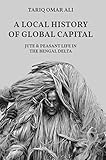A local history of global capital : jute and peasant life in the Bengal Delta / Tariq Omar Ali.
Series: Histories of economic lifePublisher: Princeton ; Oxford : Princeton University Press, 2020Copyright date: ©2018Edition: First paperback printingDescription: xv, 244 pages : maps ; 24 cmContent type:- text
- unmediated
- volume
- 9780691202570
- Jute industry -- Bengal Basin -- History
- Commodity exchanges
- Commodity exchanges
- Economic history
- Jute industry
- Social conditions
- Juteanbau
- Regionalwirtschaft
- Welthandel
- Bengal Basin -- Economic conditions -- History
- Bengal Basin -- Social conditions -- History
- India -- Bengal Basin
- Ganges-Brahmaputra-Mündungsdelta
- 382.0954
| Item type | Current library | Shelving location | Call number | Status | Notes | Date due | Barcode |
|---|---|---|---|---|---|---|---|
 BOOKs
BOOKs
|
National Law School | General Stacks | 382.0954 ALI (Browse shelf(Opens below)) | Available | Recommended by Dr. Anwesha Ghosh | 39140 |
Includes bibliographical references (pages 201-231) and index.
CONTENTS:
Acknowledgments;
Maps;
Introduction;
1 Cultivating Jute: Peasant Choice, Labor, and Hunger;
2 Consumption and Self-Fashioning: The Politics of Peasant Consumerism;
3 The Spaces of Jute: Metropolis, Hinterland, and Mofussil;
4 Immiseration;
5 Agrarian Forms of Islam: The Politics of Peasant Immiseration;
6 Peasant Populism: Electoral Politics and the “Rural Muhammadana”;
7 Pakistan and Partition: Peasant Utopia and Disillusion;
Conclusion;
Abbreviations;
Notes;
Index.
Before the advent of synthetic fibers and cargo containers, jute sacks were the preferred packaging material of global trade, transporting the world's grain, cotton, sugar, tobacco, coffee, wool, guano, and bacon. Jute was the second-most widely consumed fiber in the world, after cotton. While the sack circulated globally, the plant was cultivated almost exclusively by peasant smallholders in a small corner of the world: the Bengal delta. This book examines how jute fibers entangled the delta's peasantry in the rhythms and vicissitudes of global capital.Taking readers from the nineteenth-century high noon of the British Raj to the early years of post-partition Pakistan in the mid-twentieth century, Tariq Omar Ali traces how the global connections wrought by jute transformed every facet of peasant life: practices of work, leisure, domesticity, and sociality; ideas and discourses of justice, ethics, piety, and religiosity; and political commitments and actions. Ali examines how peasant life was structured and restructured with oscillations in global commodity markets, as the nineteenth-century period of peasant consumerism and prosperity gave way to debt and poverty in the twentieth century.A Local History of Global Capital traces how jute bound the Bengal delta's peasantry to turbulent global capital, and how global commodity markets shaped everyday peasant life and determined the difference between prosperity and poverty, survival and starvation.

There are no comments on this title.